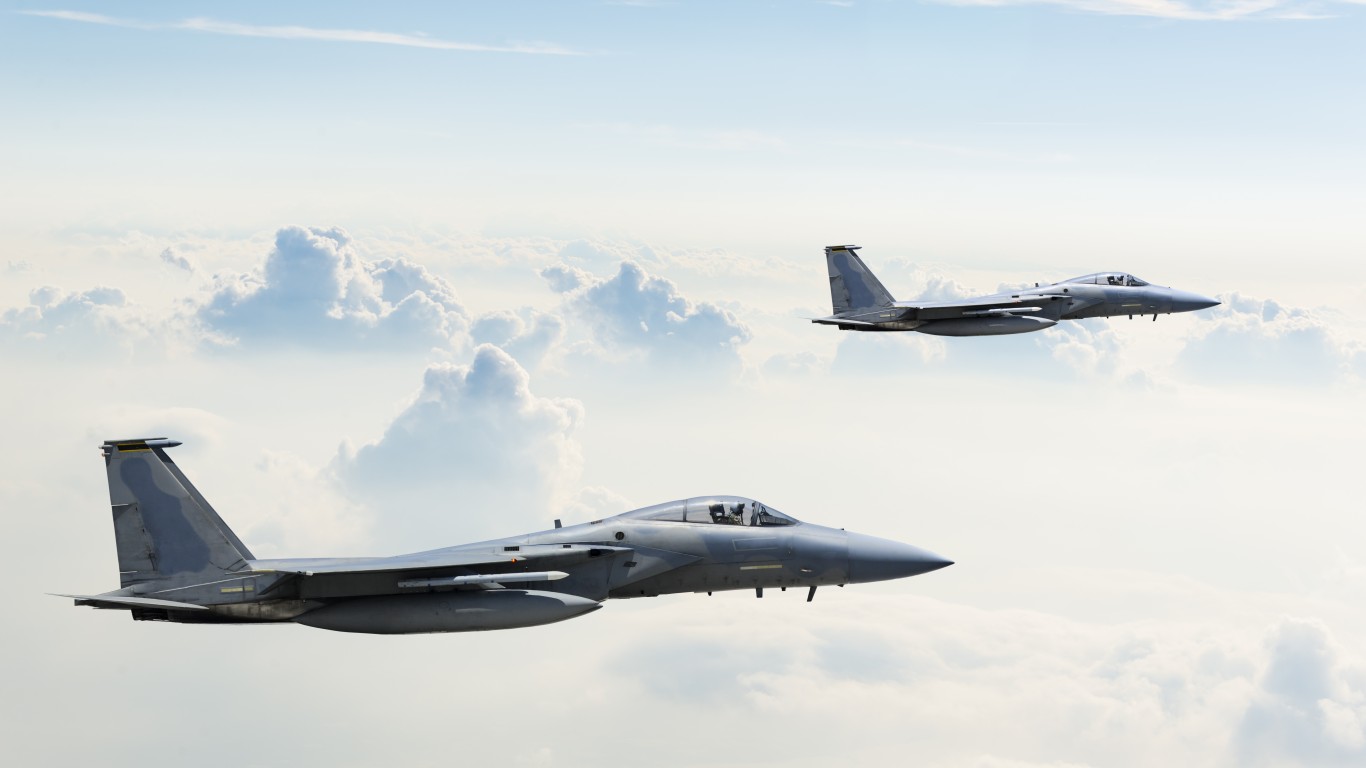
Whether establishing air superiority on the battlefield or intercepting incoming enemy aircraft, fighter jets are designed for high speed maneuverability. They are highly expensive pieces of equipment, and as a result they are often built to last. Some fighter jets still in service date back to the 1960s. (This is the U.S. Air Force’s oldest aircraft.)
To find the 10 most used combat aircraft in the world, 24/7 Wall St. reviewed aerospace publication Flight International’s 2022 World Air Forces directory. Aircraft are ranked by the number of jets that were active in military air fleets of nations around the world at the time of publication in 2021. The plane manufacturer also came from Flight International, a publication of aviation and aerospace site FlightGlobal. Information on first flights and the militaries that first used the aircraft came from a variety of online sources.
In addition to their technological advances and firepower, an interesting aspect of the fighter jets on the list is their longevity. America’s F-5 jet first flew in 1963, and there were 412 fighters active in militaries worldwide as of 2021. China’s J-7 first took flight in 1966, and there are still 445 aloft in national militaries around the world. Five other fighters from the U.S. and the former Soviet Union first flew in the 1970s. The most recent fighter on the list, the F-35 Lightning II, began flying in 2006.
Of the 10 most-used fighter jets in the world, half were initially used by the United States and three by the former Soviet Union.
Even though the U.S. government is concerned over the expanding capability of China’s and Russia’s air forces, America retains overwhelming air-power dominance. Flight International, tracks aircraft usage in six categories, and the U.S. has a combined fleet of 13,246 aircraft, or 25% of the world’s total, more than the next five-ranked nations combined: Russia, China, South Korea, India, and Japan. (These are the largest air forces in the world.)
Click here to see the top 10 most used fighter jets in the world.

10. F-5
> Number of jets in service as of 2021: 412
> Manufactured by: Northrop Grumman
> First flight: 1963
> Initially used by: United States
> Notable variants: F-5 E Tiger II (second generation)
Ever since its introduction in 1963, the F-5, built by Northrop Grumman, has proved to be a reliable, economical, and very maneuverable jet fighter. Northrop Grumman built more than 2,600 of them until it ceased production in1989. About two-thirds of the original production aircraft operate in 26 countries, including the United States.
The jet fighter has evolved from a frontline fighting machine to a training aircraft, extending its usage life.
[in-text-ad]

9. F-35 Lightning II
> Number of jets in service as of 2021: 445
> Manufactured by: Lockheed Martin
> First flight: 2006
> Initially used by: United States
> Notable variants: F-35 A (conventional takeoff); F-35 B (short take off); F-35 C (aircraft carrier)
F-35 Lightning II manufacturer Lockheed Martin touts the jet fighter as “the centerpiece of 21st century global security.” The fifth generation of the aircraft features very low observable stealth technology, advanced sensors, information fusion that creates a single integrated picture of the battlefield, and network connectivity.
Besides its long range and maneuverability, the F-35 Lightning II is known for its ability to collect, analyze, and share data. The U.S. and 14 international allies fly the F-35.
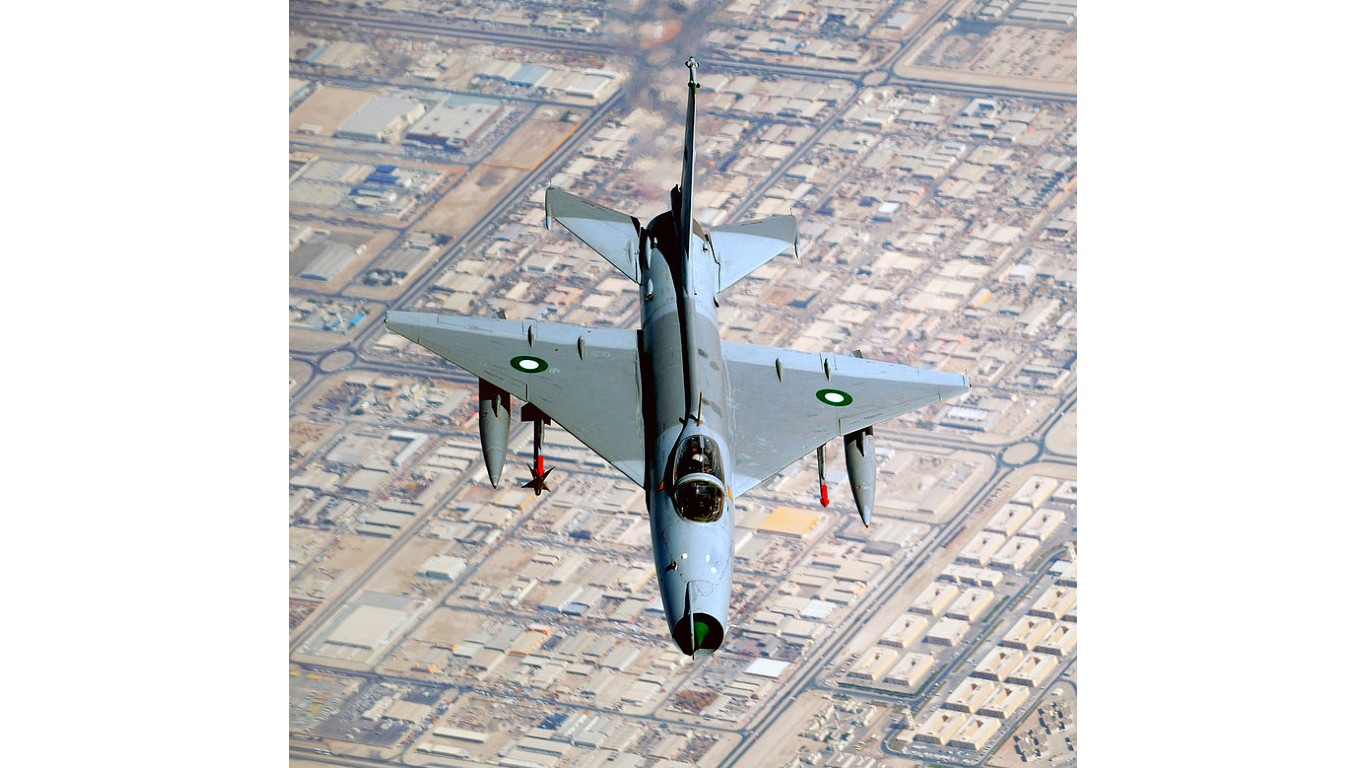
8. J-7
> Number of jets in service as of 2021: 445
> Manufactured by: Chengdu Aircraft Corporation, Guizhou Aircraft Industry Corporation
> First flight: 1966
> Initially used by: China
> Notable variants: JJ-7 (trainer)
China’s J-7 is a single-engine, lightweight fighter aircraft designed and made by Chengdu Aircraft Corp. of China. Its design is based on its predecessor, the renowned Soviet-made MiG-21 aircraft. From 1996 to 2013, more than 2,400 J-7s were built, according to Airforce Technology.
Chengdu Aircraft built two types of J-7 variants – a domestic Chinese version and an export variant. About 26 export variants are in operation worldwide, including in the air forces of Namibia, Nigeria, Bangladesh, and Pakistan.
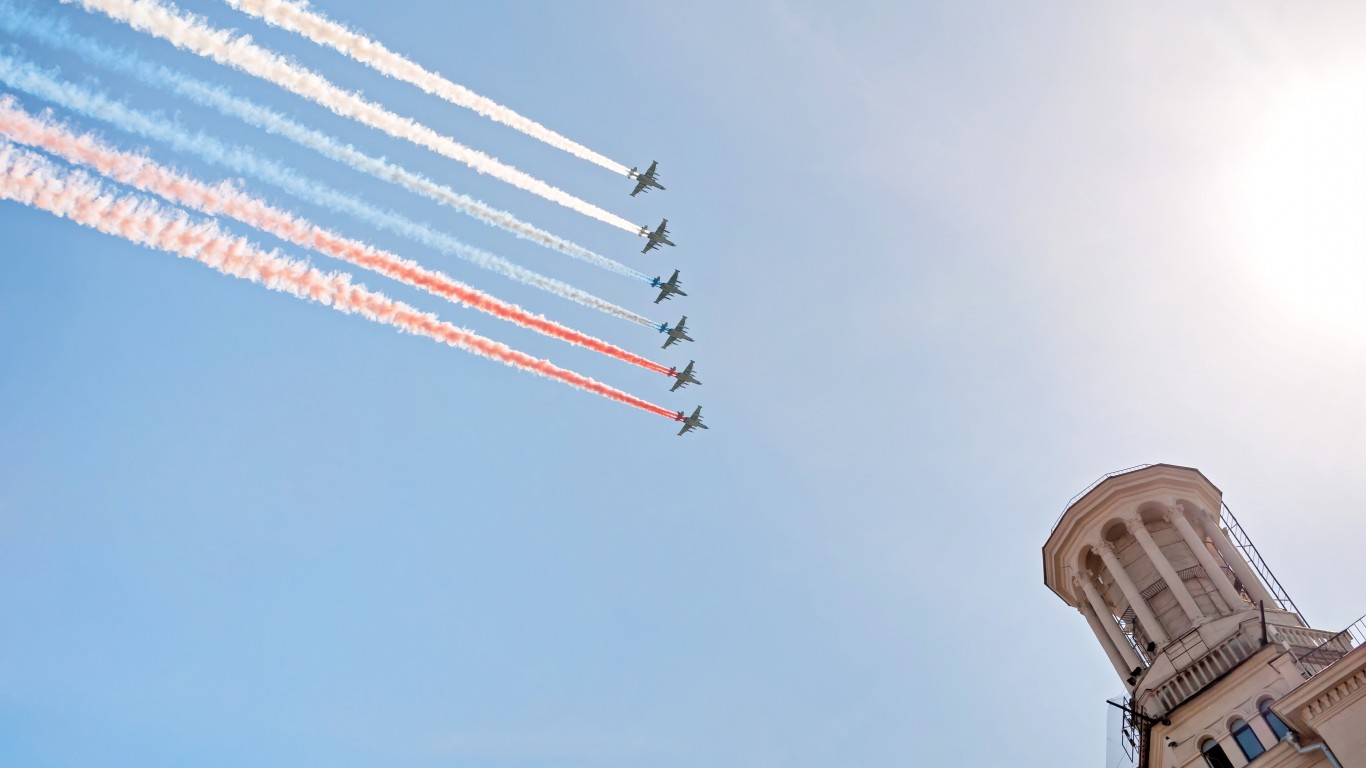
7. Su-25
> Number of jets in service as of 2021: 474
> Manufactured by: Sukhoi
> First flight: 1975
> Initially used by: Soviet Union
> Notable variants: SU-25T (antitank); Su-25 (second generation)
The Su-25, from the Soviet Union, has been involved in many conflicts since it was first built in 1975. The Sukhoi Su-25 is a single-seat, twin-engine jet aircraft designed to provide close air support for ground forces. It is believed that its distinctive nose-mounted laser rangefinder is employed to provide laser-based targeting.
The aircraft flew in the Soviet war in Afghanistan, and a variant commissioned by the Iraqi air forces performed about 900 combat sorties in its war against Iran. Many of the Iraqi Su-25s were destroyed on the ground by coalition forces during the Gulf War in 1991. Following the collapse of the Soviet Union, Russia utilized the Su-25 in both Chechan wars in the 1990s and the conflict with Georgia in 2008, in which Georgia flew its own Su-25s.
The Russian air force operates the largest number of Su-25s and had planned to upgrade older aircraft, but funding shortfalls have slowed the progress.
[in-text-ad-2]
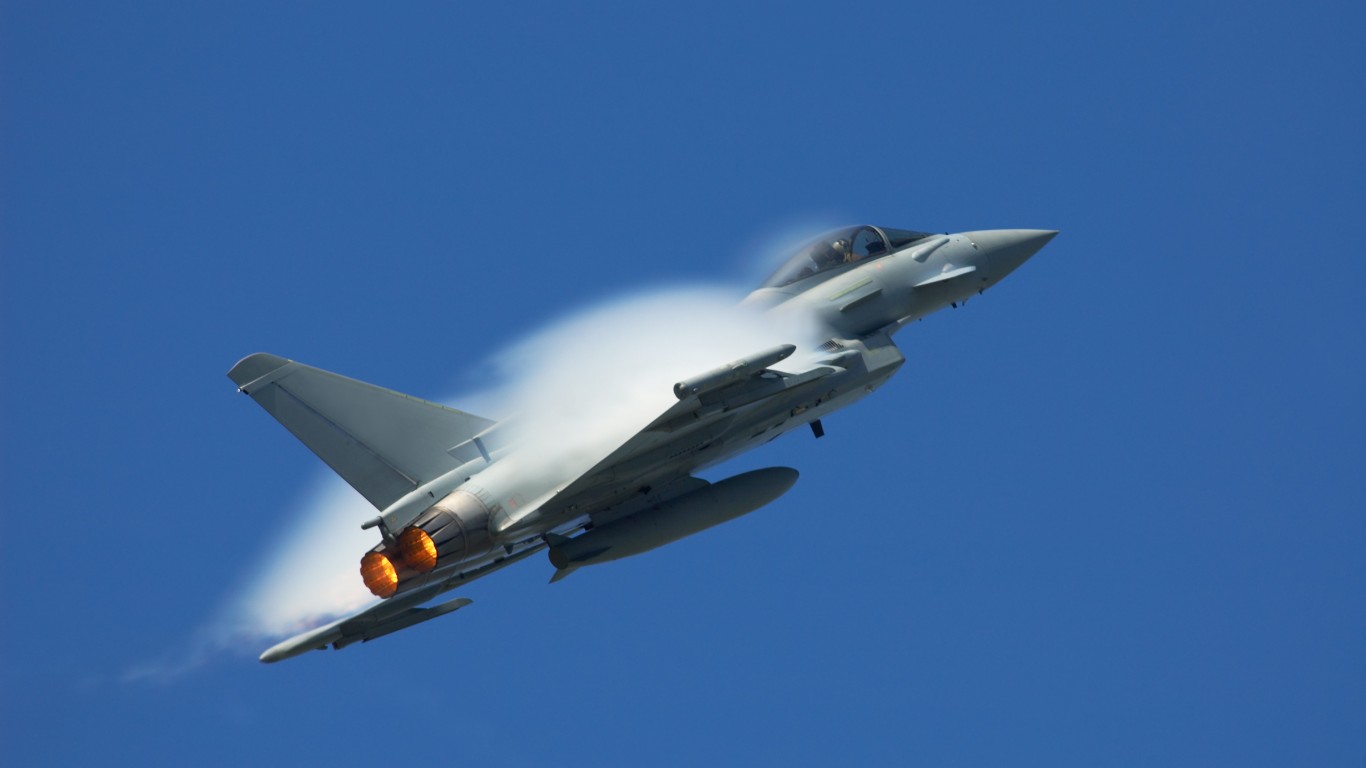
6. Eurofighter Typhoon
> Number of jets in service as of 2021: 512
> Manufactured by: Airbus, BAE Systems, Leonardo
> First flight: 1994
> Initially used by: United Kingdom, Germany, Spain, and Italy
> Notable variants: Typhoon T1A (two-seat trainers); FGR4 (single-seat, upgrade)
Eurofighter Typhoon was the most expensive combat aircraft built in Europe, developed by a consortium of British, German, Italian, and Spanish aerospace companies. Funding, technical, and design disputes among the nations involved held up production, and its launch in 1994 was two years later than expected. The manufacturers touted it as the world’s most advanced fighter aircraft.
The multirole aircraft was designed for ground attack and air defense. Its features include a target display on the pilot’s visor, voice-activated computer system, and radar. Austria and Saudi Arabia each purchased the aircraft.
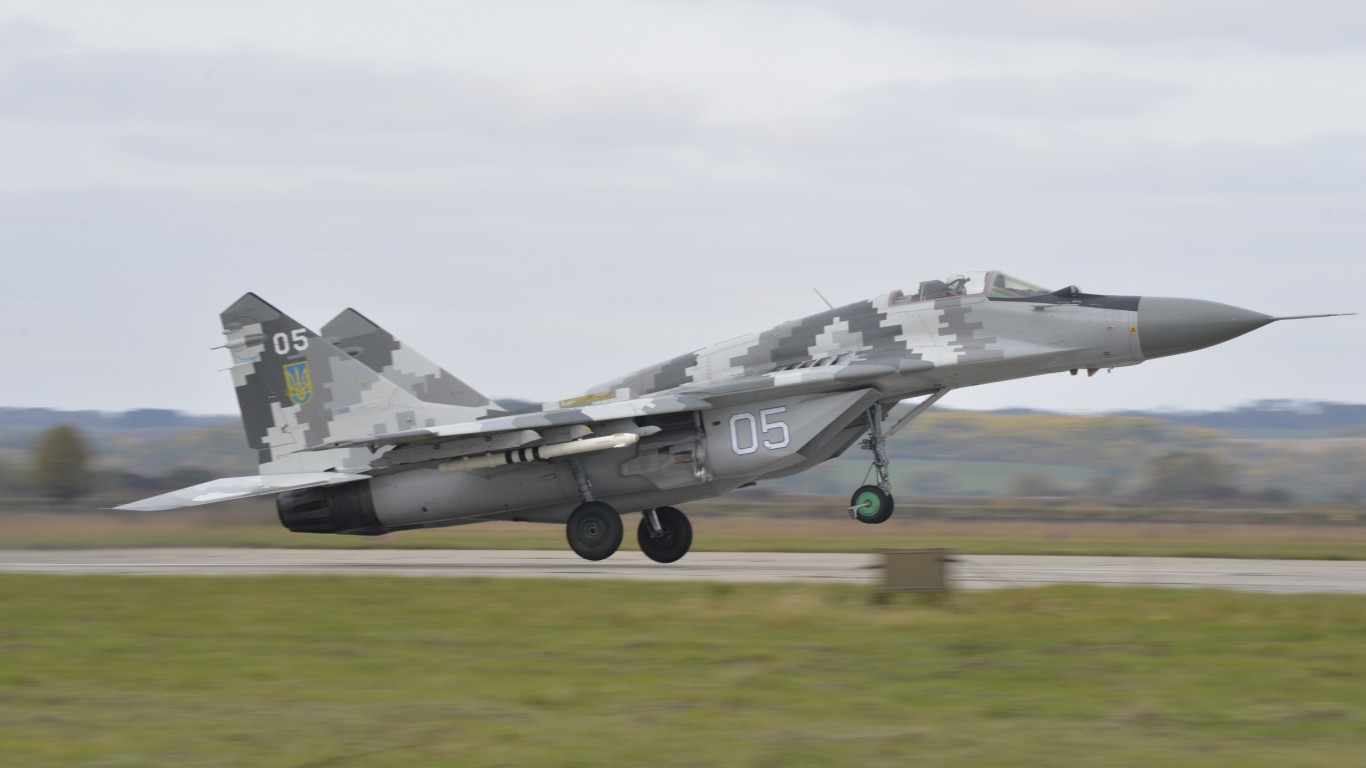
5. MiG-29
> Number of jets in service as of 2021: 822
> Manufactured by: Mikoyan-and-Gurevich Design Bureau, Russian Aircraft Corporation
> First flight: 1977
> Initially used by: Soviet Union
> Notable variants: MiG-29K (carrier-based); MiG-35 (upgraded)
The MiG-29 jet fighter was the Soviet Union’s answer to the American-made F-15 and F-16. It entered service for the Soviet air force in 1982 and was intended to oppose enemy aircraft. Its role changed to that of a multirole fighter.
MiG-29s are sometimes equipped to use a range of air-to-surface armaments and precision munitions. Their swept-back wing design provides great maneuverability.
After the Soviet Union dissolved, the MiG-29 continued to be used by the former Soviet republics, including Russia’s air force. More than 30 other countries have operated the aircraft.
[in-text-ad]
4. F/A-18 Hornet
> Number of jets in service as of 2021: 893
> Manufactured by: McDonnell Douglas, Boeing
> First flight: 1978
> Initially used by: United States
> Notable variants: F/A-18E/F Super Hornet (upgrade)
F/A-18 Hornet, flown by the U.S. Navy and U.S. Marines, is America’s first all-weather twin-engine fighter and attack aircraft. The F/A-18 entered operational service with the Marine Corps in 1983 and the U.S. Navy a year later. It proved its worth in Operation Desert Storm, the second phase of the Gulf War in 1991, by shooting down enemy aircraft and bombing targets during the same mission. The Hornet also demonstrated its survivability from direct hits from surface-to-missiles by taking only one day for repairs and returning directly to service.
The U.S. Navy’s Blu Angels perform flight demonstrations with the F/A-18 Hornet. The jet fighter has been part of the aviation strike forces of Canada, Australia, Finland, and Malaysia, among other countries.

3. F-15 Eagle
> Number of jets in service as of 2021: 963
> Manufactured by: McDonnell Douglas, Boeing
> First flight: 1972
> Initially used by: United States
> Notable variants: F-15E Strike Eagle (fighter/bomber)
The F-15E Strike Eagle is a dual-role fighter designed to perform air-to-air and air-to-ground missions. It was first put into service for the U.S. Air Force in 1974. The F-15 Eagle is known for its maneuverability and superior acceleration.
It was the first U.S. aircraft whose engines’ thrust exceeded the plane’s loaded weight. This allowed it to accelerate even while it was climbing. Its high thrust-to-weight ratio also enables it to turn without losing air speed. The F-15 Eagle’s targeting pod features a laser designator and tracking system that can mark an enemy at great distances.
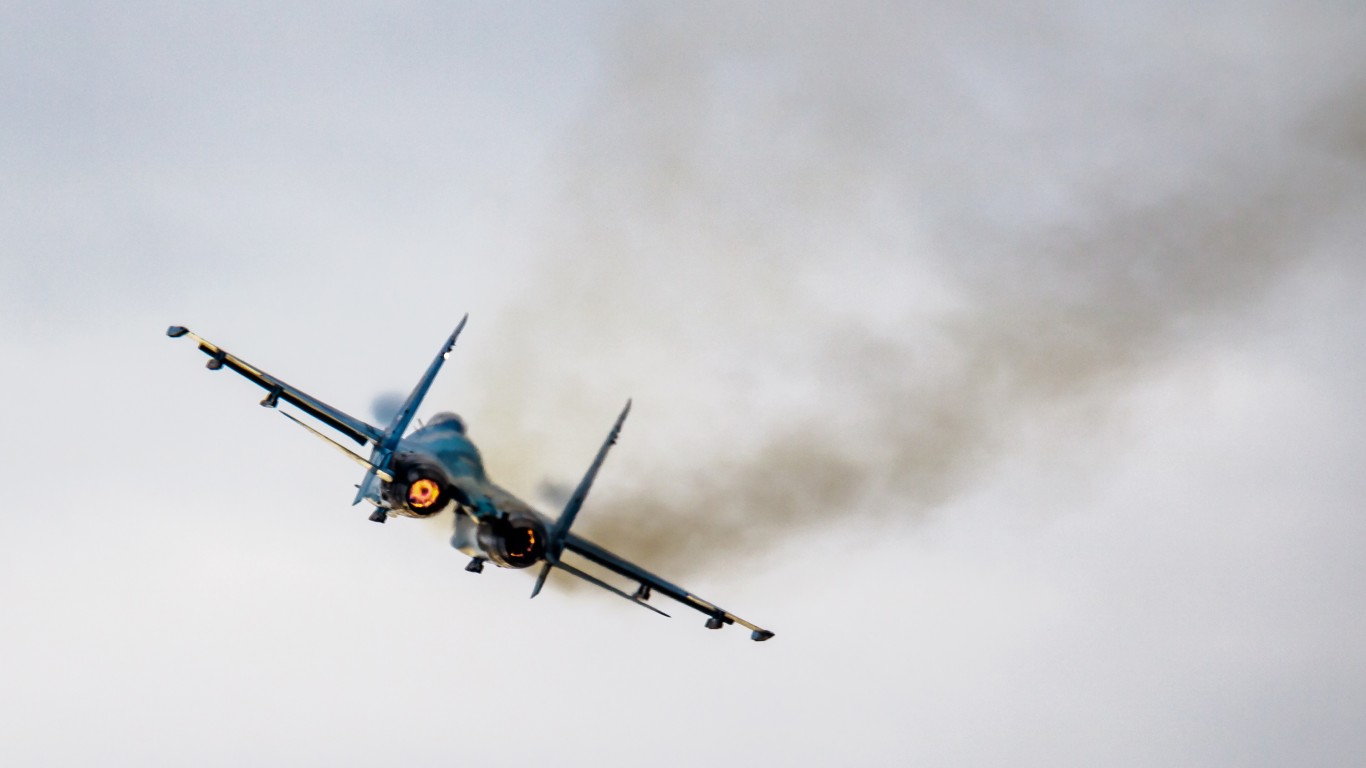
2. Su-27
> Number of jets in service as of 2021: 1,063
> Manufactured by: Sukhoi
> First flight: 1986
> Initially used by: Soviet Union
> Notable variants: Su-30 (upgrade)
The Soviet Union wanted to develop a jet fighter that could challenge the American F-15. After some technical problems that reportedly cost the lives of several Soviet pilots, the Su-27 was redesigned and eventually put into service in 1985.
Its variants are still widely used, including those flown in China, and it has lived up to its reputation as a capable and reliable jet fighter. The Su-27 has formidable armament with up to 10 air-to-air missiles. It is very maneuverable, and its robust fuel capacity allows it to work as an escort fighter.
[in-text-ad-2]
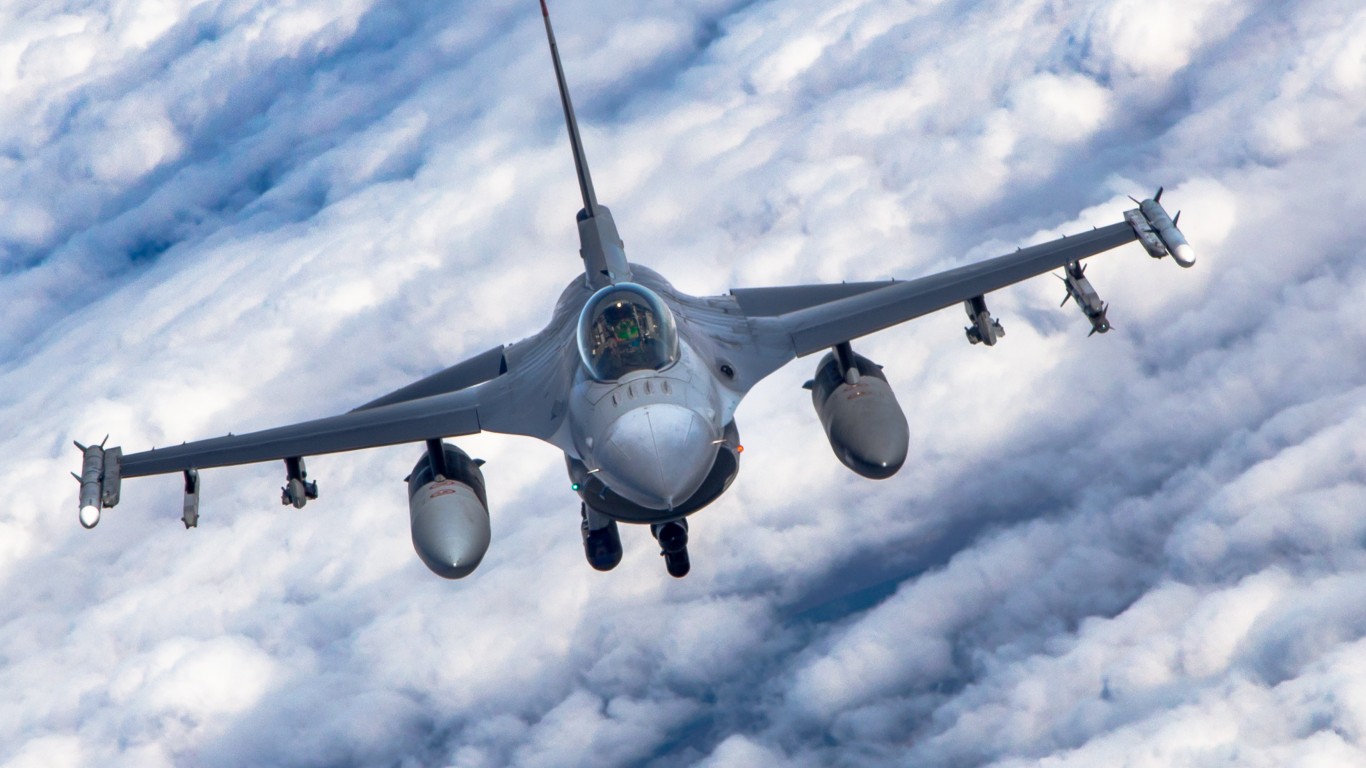
1. F-16 Fighting Falcon
> Number of jets in service as of 2021: 2,248
> Manufactured by: General Dynamics, Lockheed Martin, BAE Systems
> First flight: 1974
> Initially used by: United States
> Notable variants: F-16V (upgrade)
A group of NATO countries and the U.S. took part in manufacturing the F-16, which the Air Force named the Fighting Falcon. The multirole aircraft is a low-cost, highly maneuverable jet with a lightweight fuselage. It has proven its mettle in combat. The F-16 can withstand up to nine times the force of gravity, exceeding the capability of other fighter aircraft.
F-16 multirole fighters were deployed to the Gulf War in 1991 in support of Operation Desert Storm, where more sorties were flown with it than with any other aircraft. They attacked airfields, military production facilities, Scud missile sites, and they destroyed MiG fighters on the ground, tanks, and radar installations.
There are 2,248 F-16 Fighting Falcons still in use, more than twice the number of the next-highest jet fighter on the list.
It’s Your Money, Your Future—Own It (sponsor)
Retirement can be daunting, but it doesn’t need to be.
Imagine having an expert in your corner to help you with your financial goals. Someone to help you determine if you’re ahead, behind, or right on track. With SmartAsset, that’s not just a dream—it’s reality. This free tool connects you with pre-screened financial advisors who work in your best interests. It’s quick, it’s easy, so take the leap today and start planning smarter!
Don’t waste another minute; get started right here and help your retirement dreams become a retirement reality.
Thank you for reading! Have some feedback for us?
Contact the 24/7 Wall St. editorial team.
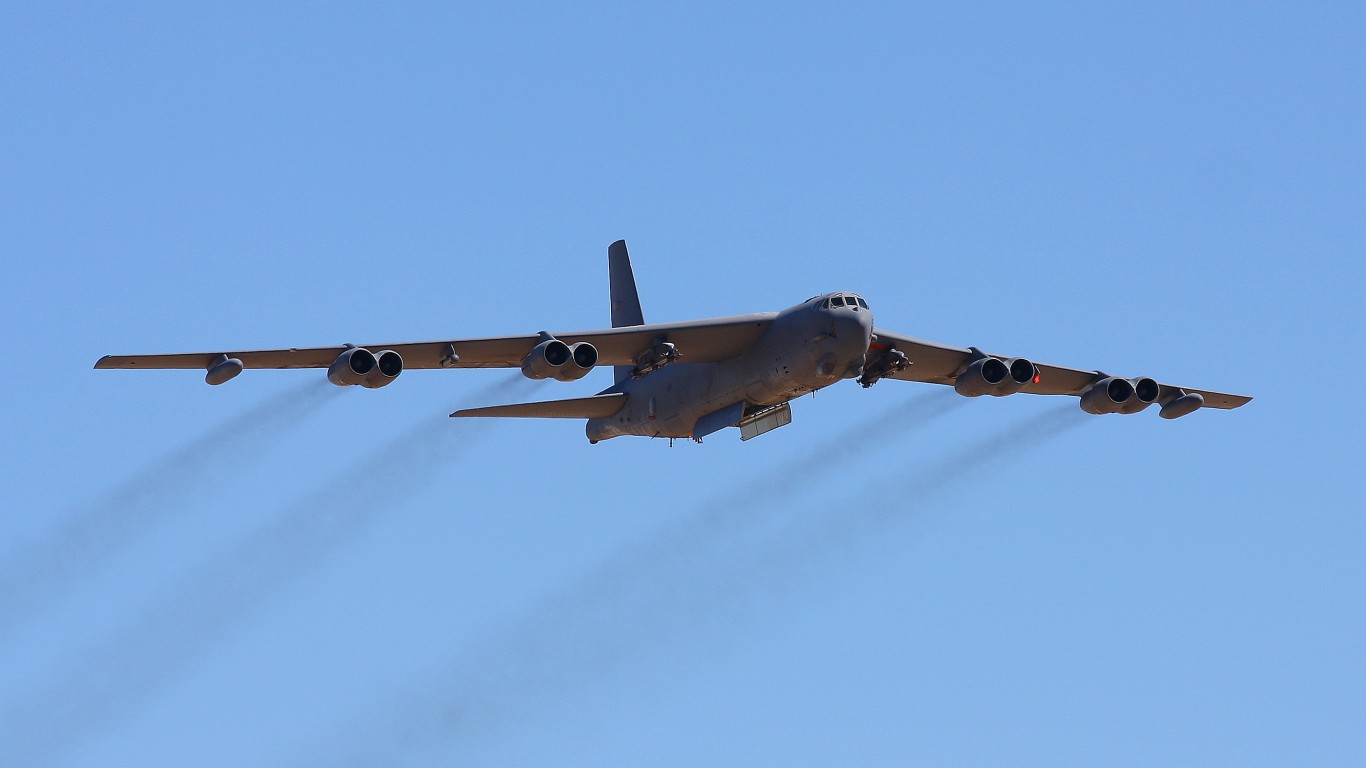 24/7 Wall St.
24/7 Wall St.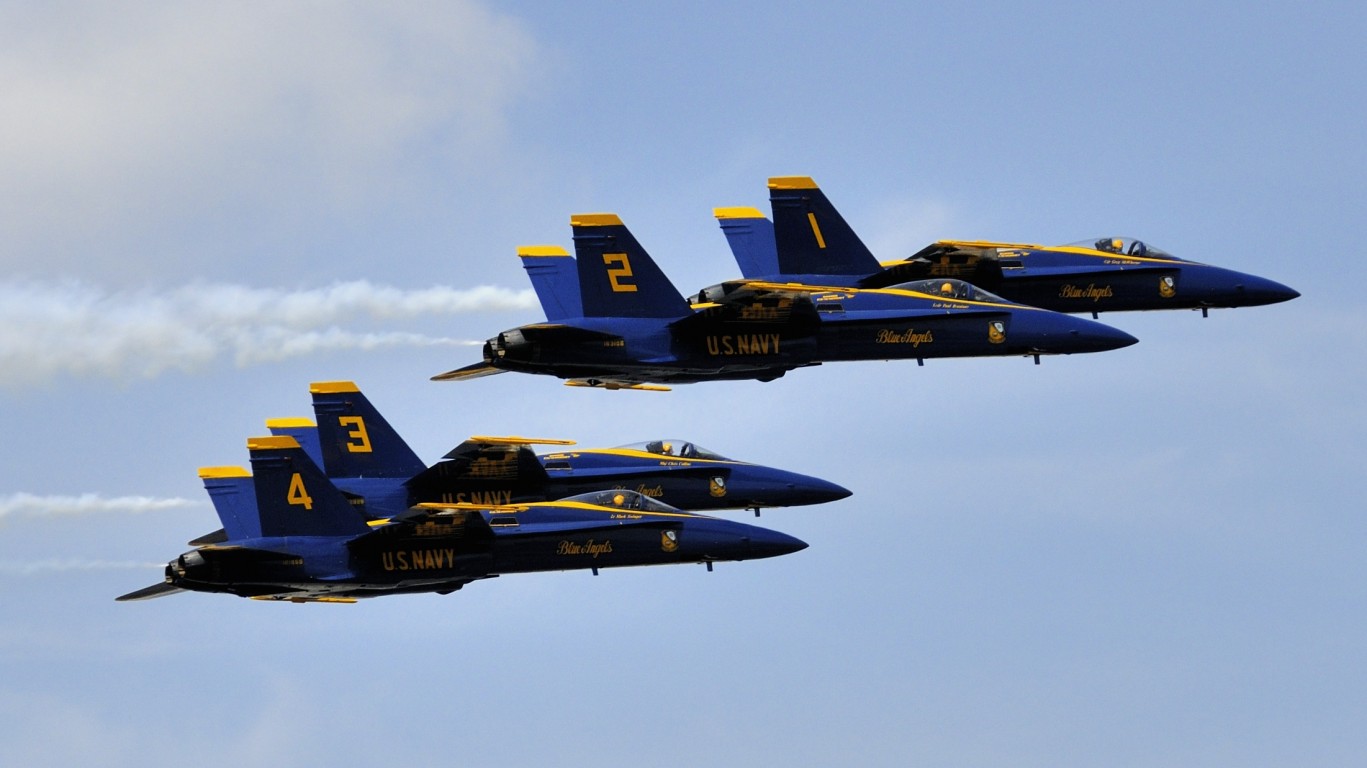
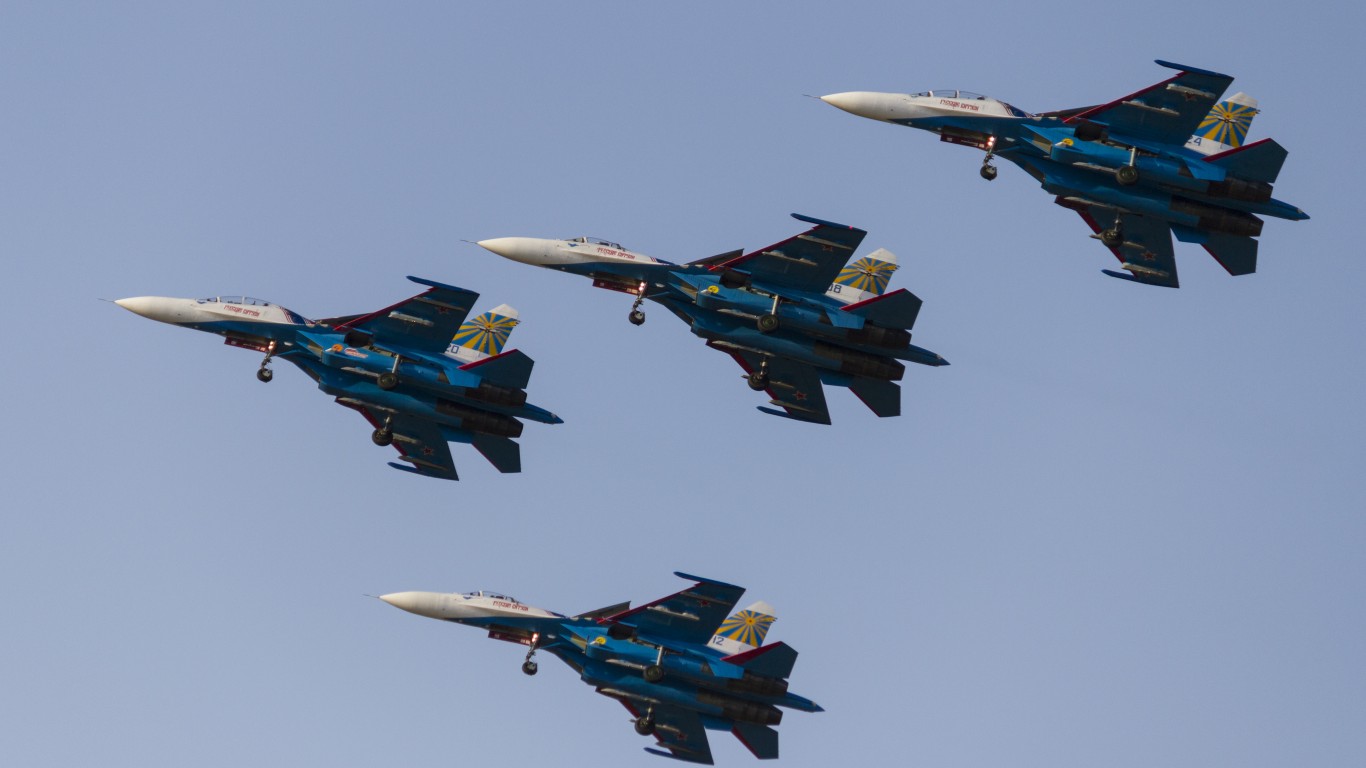 24/7 Wall St.
24/7 Wall St.